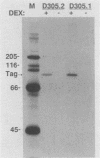Abstract
IMR-90 normal human diploid fibroblasts, transfected with a steroid inducible mouse mammary tumor virus-driven simian virus 40 T antigen, were carried through crisis to yield an immortal cell line. Growth was dependent on the presence of the inducer (dexamethasone) during both the extended precrisis life span of the cells and after immortalization. After dexamethasone removal, immortal cells divided once or twice and then accumulated in G1. These results are best explained by a two-stage model for cellular senescence. Mortality stage 1 (M1) causes a loss of mitogen responsiveness and arrest near the G1/S interface and can be bypassed or overcome by the cellular DNA synthesis-stimulating activity of T antigen. Mortality stage 2 (M2) is an independent mechanism that is responsible for the failure of cell division during crisis. The inactivation of M2 is a rare event, probably of mutational origin in human cells, independent of or only indirectly related to the expression of T antigen. Under this hypothesis, T-antigen-immortalized cells contain an active but bypassed M1 mechanism and an inactivated M2 mechanism. These cells are dependent on the continued expression of T antigen for the maintenance of immortality for the same reason that precrisis cells are dependent on T antigen for growth: both contain an active M1 mechanism.
Full text
PDF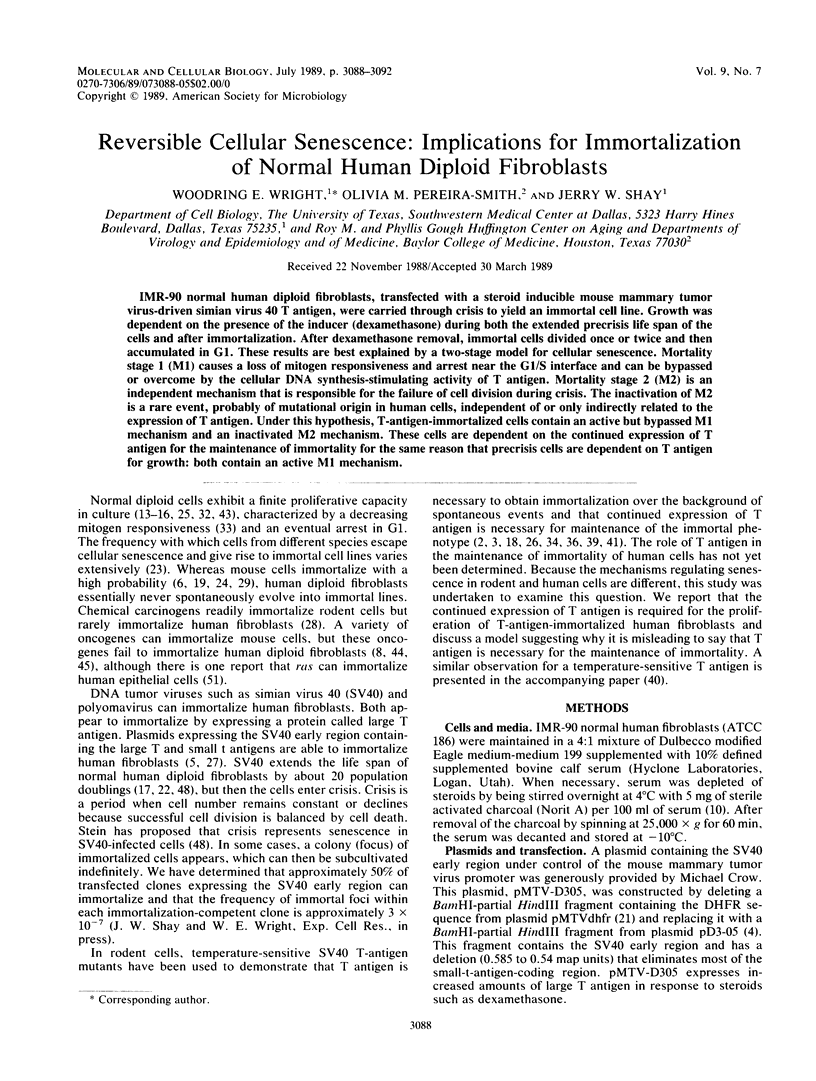
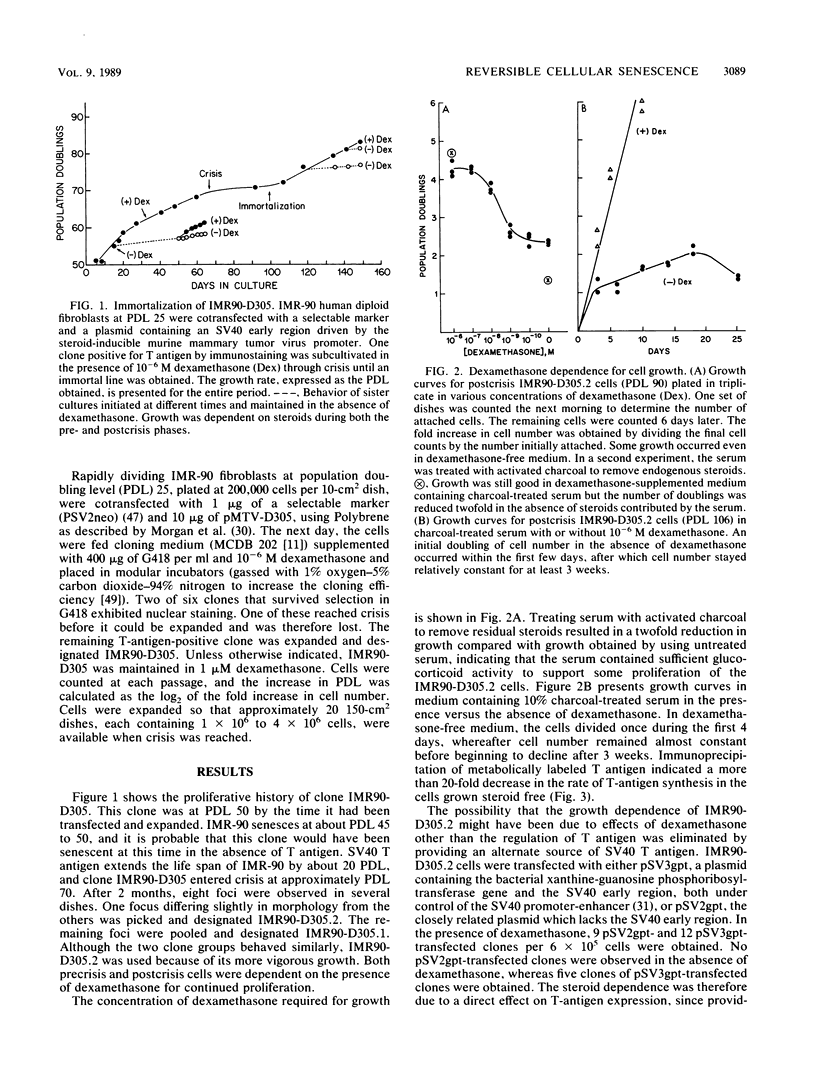
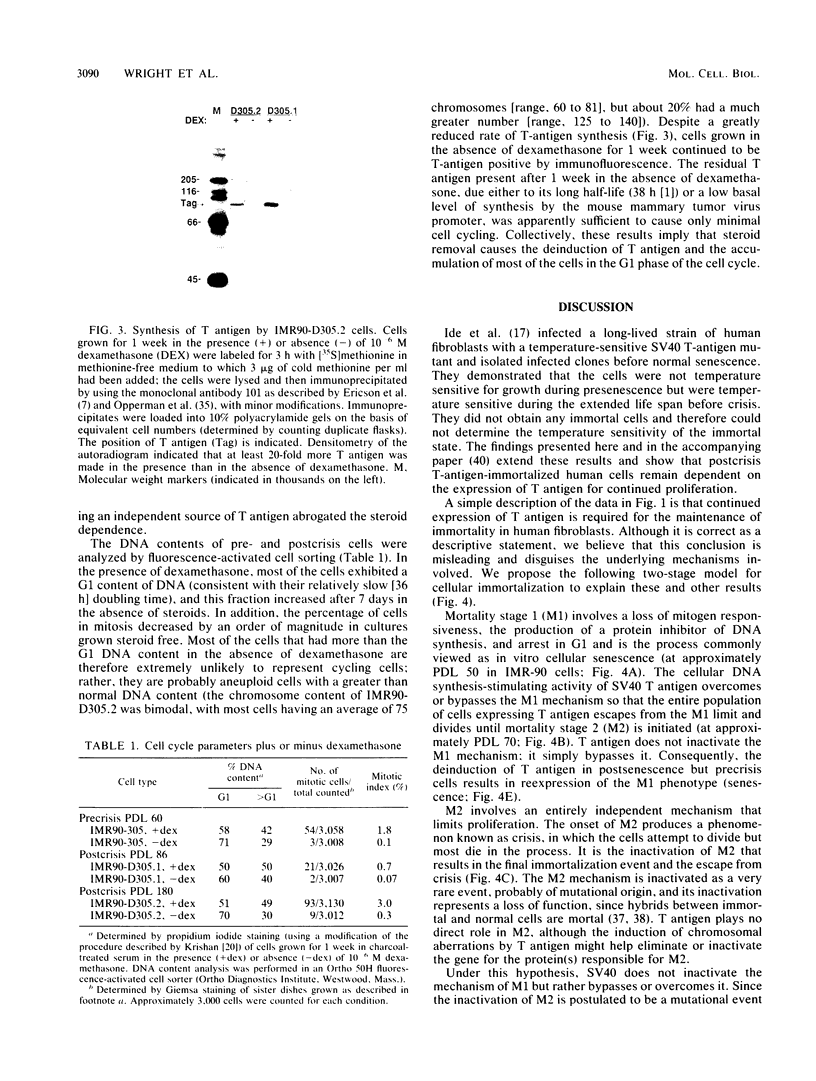
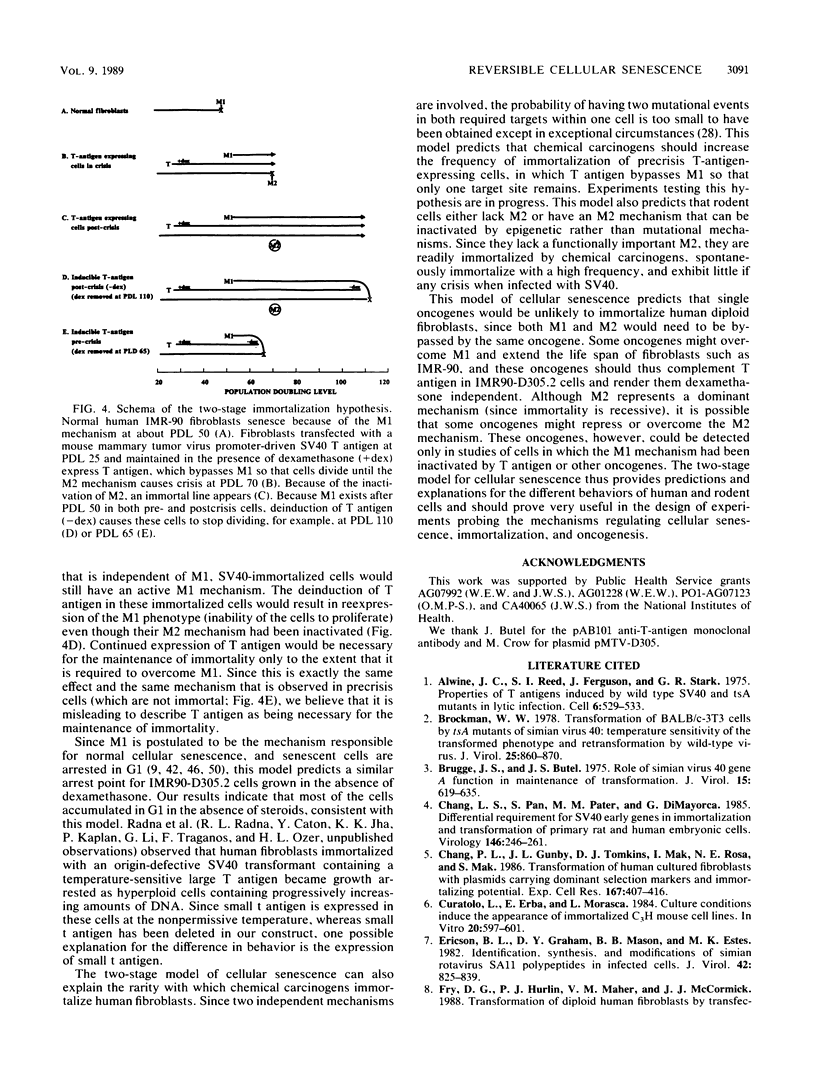
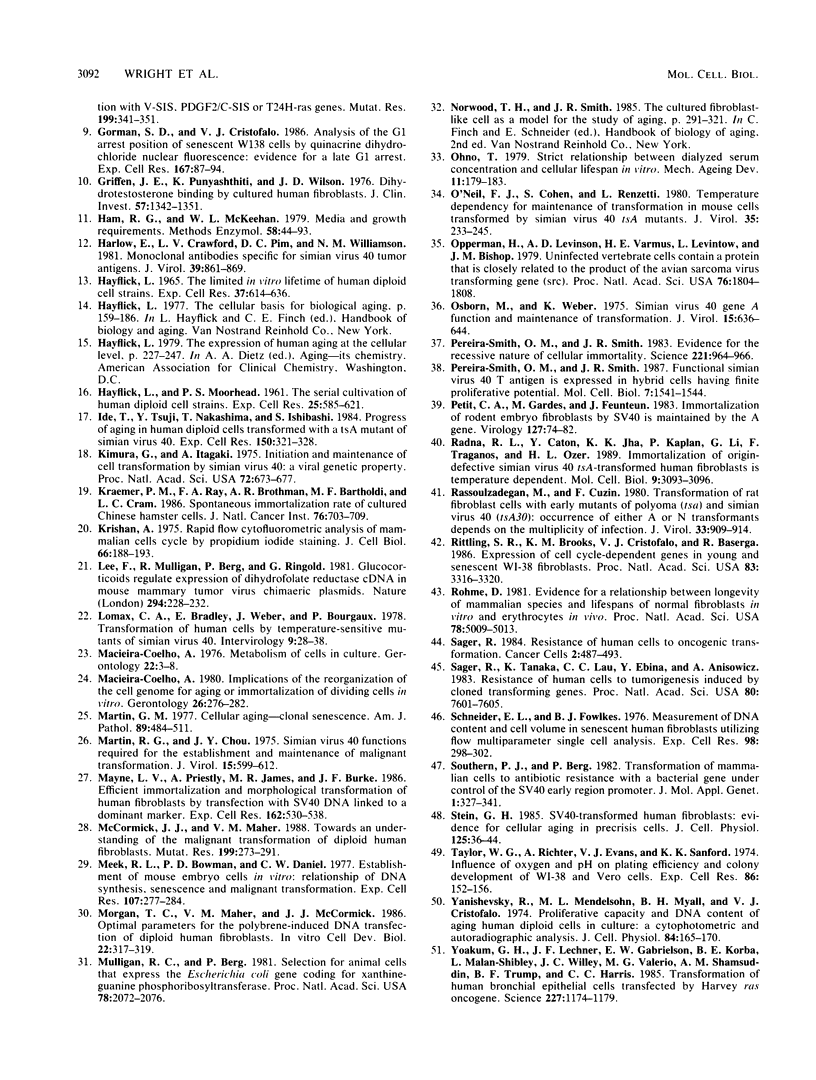
Images in this article
Selected References
These references are in PubMed. This may not be the complete list of references from this article.
- Brockman W. W. Transformation of BALB/c-3T3 cells by tsA mutants of simian virus 40: temperature sensitivity of the transformed phenotype and retransofrmation by wild-type virus. J Virol. 1978 Mar;25(3):860–870. doi: 10.1128/jvi.25.3.860-870.1978. [DOI] [PMC free article] [PubMed] [Google Scholar]
- Brugge J. S., Butel J. S. Role of simian virus 40 gene A function in maintenance of transformation. J Virol. 1975 Mar;15(3):619–635. doi: 10.1128/jvi.15.3.619-635.1975. [DOI] [PMC free article] [PubMed] [Google Scholar]
- Chang L. S., Pan S., Pater M. M., Di Mayorca G. Differential requirement for SV40 early genes in immortalization and transformation of primary rat and human embryonic cells. Virology. 1985 Oct 30;146(2):246–261. doi: 10.1016/0042-6822(85)90008-x. [DOI] [PubMed] [Google Scholar]
- Chang P. L., Gunby J. L., Tomkins D. J., Mak I., Rosa N. E., Mak S. Transformation of human cultured fibroblasts with plasmids carrying dominant selection markers and immortalizing potential. Exp Cell Res. 1986 Dec;167(2):407–416. doi: 10.1016/0014-4827(86)90181-3. [DOI] [PubMed] [Google Scholar]
- Curatolo L., Erba E., Morasca L. Culture conditions induce the appearance of immortalized C3H mouse cell lines. In Vitro. 1984 Aug;20(8):597–601. doi: 10.1007/BF02619607. [DOI] [PubMed] [Google Scholar]
- Ericson B. L., Graham D. Y., Mason B. B., Estes M. K. Identification, synthesis, and modifications of simian rotavirus SA11 polypeptides in infected cells. J Virol. 1982 Jun;42(3):825–839. doi: 10.1128/jvi.42.3.825-839.1982. [DOI] [PMC free article] [PubMed] [Google Scholar]
- Gorman S. D., Cristofalo V. J. Analysis of the G1 arrest position of senescent WI38 cells by quinacrine dihydrochloride nuclear fluorescence. Evidence for a late G1 arrest. Exp Cell Res. 1986 Nov;167(1):87–94. doi: 10.1016/0014-4827(86)90206-5. [DOI] [PubMed] [Google Scholar]
- Griffin J. E., Punyashthiti K., Wilson J. D. Dihydrotestosterone binding by cultured human fibroblasts. Comparison of cells from control subjects and from patients with hereditary male pseudohermaphroditism due to androgen resistance. J Clin Invest. 1976 May;57(5):1342–1351. doi: 10.1172/JCI108402. [DOI] [PMC free article] [PubMed] [Google Scholar]
- HAYFLICK L. THE LIMITED IN VITRO LIFETIME OF HUMAN DIPLOID CELL STRAINS. Exp Cell Res. 1965 Mar;37:614–636. doi: 10.1016/0014-4827(65)90211-9. [DOI] [PubMed] [Google Scholar]
- Ham R. G., McKeehan W. L. Media and growth requirements. Methods Enzymol. 1979;58:44–93. doi: 10.1016/s0076-6879(79)58126-9. [DOI] [PubMed] [Google Scholar]
- Harlow E., Crawford L. V., Pim D. C., Williamson N. M. Monoclonal antibodies specific for simian virus 40 tumor antigens. J Virol. 1981 Sep;39(3):861–869. doi: 10.1128/jvi.39.3.861-869.1981. [DOI] [PMC free article] [PubMed] [Google Scholar]
- Ide T., Tsuji Y., Nakashima T., Ishibashi S. Progress of aging in human diploid cells transformed with a tsA mutant of simian virus 40. Exp Cell Res. 1984 Feb;150(2):321–328. doi: 10.1016/0014-4827(84)90575-5. [DOI] [PubMed] [Google Scholar]
- Kimura G., Itagaki A. Initiation and maintenance of cell transformation by simian virus 40: a viral genetic property. Proc Natl Acad Sci U S A. 1975 Feb;72(2):673–677. doi: 10.1073/pnas.72.2.673. [DOI] [PMC free article] [PubMed] [Google Scholar]
- Kraemer P. M., Ray F. A., Brothman A. R., Bartholdi M. F., Cram L. S. Spontaneous immortalization rate of cultured Chinese hamster cells. J Natl Cancer Inst. 1986 Apr;76(4):703–709. doi: 10.1093/jnci/76.4.703. [DOI] [PubMed] [Google Scholar]
- Krishan A. Rapid flow cytofluorometric analysis of mammalian cell cycle by propidium iodide staining. J Cell Biol. 1975 Jul;66(1):188–193. doi: 10.1083/jcb.66.1.188. [DOI] [PMC free article] [PubMed] [Google Scholar]
- Lee F., Mulligan R., Berg P., Ringold G. Glucocorticoids regulate expression of dihydrofolate reductase cDNA in mouse mammary tumour virus chimaeric plasmids. Nature. 1981 Nov 19;294(5838):228–232. doi: 10.1038/294228a0. [DOI] [PubMed] [Google Scholar]
- Lomax C. A., Bradley E., Weber J., Bourgaux P. Transformation of human cells by temperature-sensitive mutants of simian virus-40. Intervirology. 1978;9(1):28–38. doi: 10.1159/000148918. [DOI] [PubMed] [Google Scholar]
- Macieira-Coelho A. Implications of the reorganization of the cell genome for aging or immortalization of dividing cells in vitro. Gerontology. 1980;26(5):276–282. doi: 10.1159/000212428. [DOI] [PubMed] [Google Scholar]
- Macieira-Coelho A. Metabolism of aging cells in culture. Introduction. Gerontology. 1976;22(1-2):3–8. doi: 10.1159/000212121. [DOI] [PubMed] [Google Scholar]
- Martin G. M. Cellular aging--clonal senescence. A review (Part I). Am J Pathol. 1977 Nov;89(2):484–512. [PMC free article] [PubMed] [Google Scholar]
- Martin R. G., Chou J. Y. Simian virus 40 functions required for the establishment and maintenance of malignant transformation. J Virol. 1975 Mar;15(3):599–612. doi: 10.1128/jvi.15.3.599-612.1975. [DOI] [PMC free article] [PubMed] [Google Scholar]
- Mayne L. V., Priestley A., James M. R., Burke J. F. Efficient immortalization and morphological transformation of human fibroblasts by transfection with SV40 DNA linked to a dominant marker. Exp Cell Res. 1986 Feb;162(2):530–538. doi: 10.1016/0014-4827(86)90356-3. [DOI] [PubMed] [Google Scholar]
- McCormick J. J., Maher V. M. Towards an understanding of the malignant transformation of diploid human fibroblasts. Mutat Res. 1988 Jun;199(2):273–291. doi: 10.1016/0027-5107(88)90209-6. [DOI] [PubMed] [Google Scholar]
- Meek R. L., Bowman P. D., Daniel C. W. Establishment of mouse embryo cells in vitro. Relationship of DNA synthesis, senescence and malignant transformation. Exp Cell Res. 1977 Jul;107(2):277–284. doi: 10.1016/0014-4827(77)90350-0. [DOI] [PubMed] [Google Scholar]
- Morgan T. L., Maher V. M., McCormick J. J. Optimal parameters for the polybrene-induced DNA transfection of diploid human fibroblasts. In Vitro Cell Dev Biol. 1986 Jun;22(6):317–319. doi: 10.1007/BF02623404. [DOI] [PubMed] [Google Scholar]
- Mulligan R. C., Berg P. Selection for animal cells that express the Escherichia coli gene coding for xanthine-guanine phosphoribosyltransferase. Proc Natl Acad Sci U S A. 1981 Apr;78(4):2072–2076. doi: 10.1073/pnas.78.4.2072. [DOI] [PMC free article] [PubMed] [Google Scholar]
- O'Neill F. J., Cohen S., Renzetti L. Temperature dependency for maintenance of transformation in mouse cells transformed by simian virus 40 tsA mutants. J Virol. 1980 Jul;35(1):233–245. doi: 10.1128/jvi.35.1.233-245.1980. [DOI] [PMC free article] [PubMed] [Google Scholar]
- Ohno T. Strict relationship between dialyzed serum concentration and cellular life span in vitro. Mech Ageing Dev. 1979 Oct;11(3):179–183. doi: 10.1016/0047-6374(79)90053-8. [DOI] [PubMed] [Google Scholar]
- Oppermann H., Levinson A. D., Varmus H. E., Levintow L., Bishop J. M. Uninfected vertebrate cells contain a protein that is closely related to the product of the avian sarcoma virus transforming gene (src). Proc Natl Acad Sci U S A. 1979 Apr;76(4):1804–1808. doi: 10.1073/pnas.76.4.1804. [DOI] [PMC free article] [PubMed] [Google Scholar]
- Osborn M., Weber K. Simian virus 40 gene A function and maintenance of transformation. J Virol. 1975 Mar;15(3):636–644. doi: 10.1128/jvi.15.3.636-644.1975. [DOI] [PMC free article] [PubMed] [Google Scholar]
- Pereira-Smith O. M., Smith J. R. Evidence for the recessive nature of cellular immortality. Science. 1983 Sep 2;221(4614):964–966. doi: 10.1126/science.6879195. [DOI] [PubMed] [Google Scholar]
- Pereira-Smith O. M., Smith J. R. Functional simian virus 40 T antigen is expressed in hybrid cells having finite proliferative potential. Mol Cell Biol. 1987 Apr;7(4):1541–1544. doi: 10.1128/mcb.7.4.1541. [DOI] [PMC free article] [PubMed] [Google Scholar]
- Petit C. A., Gardes M., Feunteun J. Immortalization of rodent embryo fibroblasts by SV40 is maintained by the A gene. Virology. 1983 May;127(1):74–82. doi: 10.1016/0042-6822(83)90372-0. [DOI] [PubMed] [Google Scholar]
- Radna R. L., Caton Y., Jha K. K., Kaplan P., Li G., Traganos F., Ozer H. L. Growth of immortal simian virus 40 tsA-transformed human fibroblasts is temperature dependent. Mol Cell Biol. 1989 Jul;9(7):3093–3096. doi: 10.1128/mcb.9.7.3093. [DOI] [PMC free article] [PubMed] [Google Scholar]
- Rassoulzadegan M., Cuzin F. Transformation of rat fibroblast cells with early mutants of polyoma (tsa) and simian virus 40 (tsA30): occurrence of either A or N transformants depends on the multiplicity of infection. J Virol. 1980 Feb;33(2):909–911. doi: 10.1128/jvi.33.2.909-911.1980. [DOI] [PMC free article] [PubMed] [Google Scholar]
- Rittling S. R., Brooks K. M., Cristofalo V. J., Baserga R. Expression of cell cycle-dependent genes in young and senescent WI-38 fibroblasts. Proc Natl Acad Sci U S A. 1986 May;83(10):3316–3320. doi: 10.1073/pnas.83.10.3316. [DOI] [PMC free article] [PubMed] [Google Scholar]
- Röhme D. Evidence for a relationship between longevity of mammalian species and life spans of normal fibroblasts in vitro and erythrocytes in vivo. Proc Natl Acad Sci U S A. 1981 Aug;78(8):5009–5013. doi: 10.1073/pnas.78.8.5009. [DOI] [PMC free article] [PubMed] [Google Scholar]
- Sager R., Tanaka K., Lau C. C., Ebina Y., Anisowicz A. Resistance of human cells to tumorigenesis induced by cloned transforming genes. Proc Natl Acad Sci U S A. 1983 Dec;80(24):7601–7605. doi: 10.1073/pnas.80.24.7601. [DOI] [PMC free article] [PubMed] [Google Scholar]
- Schneider E. L., Fowlkes B. J. Measurement of DNA content and cell volume in senescent human fibroblasts utilizing flow multiparameter single cell analysis. Exp Cell Res. 1976 Mar 15;98(2):298–302. doi: 10.1016/0014-4827(76)90441-9. [DOI] [PubMed] [Google Scholar]
- Southern P. J., Berg P. Transformation of mammalian cells to antibiotic resistance with a bacterial gene under control of the SV40 early region promoter. J Mol Appl Genet. 1982;1(4):327–341. [PubMed] [Google Scholar]
- Stein G. H. SV40-transformed human fibroblasts: evidence for cellular aging in pre-crisis cells. J Cell Physiol. 1985 Oct;125(1):36–44. doi: 10.1002/jcp.1041250106. [DOI] [PubMed] [Google Scholar]
- Taylor W. G., Richter A., Evans V. J., Sanford K. K. Influence of oxygen and pH on plating efficiency and colony development of WI-38 and Vero cells. Exp Cell Res. 1974 May;86(1):152–156. doi: 10.1016/0014-4827(74)90660-0. [DOI] [PubMed] [Google Scholar]
- Yanishevsky R., Mendelsohn M. L., Mayall B. H., Cristofalo V. J. Proliferative capacity and DNA content of aging human diploid cells in culture: a cytophotometric and autoradiographic analysis. J Cell Physiol. 1974 Oct;84(2):165–170. doi: 10.1002/jcp.1040840202. [DOI] [PubMed] [Google Scholar]
- Yoakum G. H., Lechner J. F., Gabrielson E. W., Korba B. E., Malan-Shibley L., Willey J. C., Valerio M. G., Shamsuddin A. M., Trump B. F., Harris C. C. Transformation of human bronchial epithelial cells transfected by Harvey ras oncogene. Science. 1985 Mar 8;227(4691):1174–1179. doi: 10.1126/science.3975607. [DOI] [PubMed] [Google Scholar]



